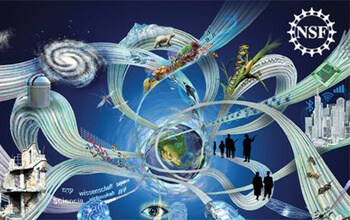National Science Foundation (NSF) Director France A. Córdova today publicly presented President Donald J. Trump’s Fiscal Year (FY) 2018 NSF budget request to Congress.
The FY 2018 NSF budget request of $6.65 billion reflects NSF’s commitment to establishing clear priorities in areas of national importance and identifying the most innovative and promising research ideas that will yield the highest return on investment for the nation. It supports fundamental research that will drive the U.S. economy, support our nation’s security, and keep the U.S. a global leader in science, engineering and technology.
“For nearly seven decades, NSF investments in fundamental and transformational research have catalyzed discoveries that impact the lives and livelihoods of all Americans,” Córdova said. “This proposal allows us to determine the priorities for funding across the spectrum of science and engineering; facilitates interdisciplinary research and our goal to broaden participation in science; funds the construction of large facilities that will transform our understanding of nature; and seeds innovation and discovery by initiating our 10 Big Ideas.”
Detailed information on the FY 2018 budget request is available beginning today on the NSF website.
NSF continues to bring together researchers from all fields of science and engineering to address today’s challenges through foundation-wide activities. The agency continues to efficiently invest in the fundamental research and talented people who make the innovative discoveries that transform our future. NSF remains committed to supporting cross-disciplinary investments that would have significant scientific, national and societal impact.
Under the budget request:
- Cyber-Enabled Materials, Manufacturing, and Smart Systems (CEMMSS) would receive $222.43 million. This investment aims to integrate science and engineering activities across NSF, including breakthrough materials, advanced manufacturing and smart systems, which include robotics and cyber-physical systems.
- Inclusion across the Nation of Communities of Learners of Underrepresented Discoverers in Engineering and Science (NSF INCLUDES) would receive $14.88 million. This is an integrated, national initiative to increase the preparation, participation, advancement and potential contributions of those who have been traditionally underserved or underrepresented in the science, technology, engineering and mathematics (STEM) enterprise.
- Innovations at the Nexus of Food, Energy and Water Systems (INFEWS) would receive $24.4 million. This investment aims to understand, design and model interconnected food, energy and water system through an interdisciplinary research effort that incorporates all areas of science and engineering and addresses the natural, social and human-built factors involved.
- NSF Innovation Corps (I-Corps) would receive $26.15 million. This program improves NSF-funded researchers’ access to resources that can assist in bridging the gap between discoveries and technologies, helping to transfer knowledge to downstream technological applications and use at scale.
- Risk and Resilience investments would receive $31.15 million to improve predictability and risk assessment and increase preparedness for extreme natural and man-made events to reduce their impact on quality of life, society and the economy.
- Secure and Trustworthy Cyberspace (SaTC) would receive $113.75 million. This investment aims to build the knowledge base in cybersecurity that enables discovery, learning and innovation, and leads to a more secure and trustworthy cyberspace.
- Understanding the Brain (UtB) would receive $134.46 million. This initiative encompasses ongoing cognitive science and neuroscience research and NSF’s contributions to the ongoing Brain Research through Advancing Innovation and Neurotechnologies (BRAIN) Initiative. The goal of UtB is to enable scientific understanding of the full complexity of the brain, in action and in context.
In FY 2016, NSF provided 27 percent of total federal support for academic basic research in all science and engineering fields in the United States. Approximately 2,000 U.S. colleges, universities and other institutions received NSF funding. The vast majority of NSF’s funding — about 93 percent — is committed to supporting research, education and related activities. Thus, most of NSF’s budget goes back to states and localities through the grants and awards the agency makes.
NSF expects to evaluate over 50,000 proposals in FY 2018 and, through its competitive merit review process, make nearly 11,000 awards, including 8,000 new research grants. Reflecting a decrease of $841 million from the FY 2016 actuals, this is an estimated funding rate of 19 percent, down from 21 percent in FY 2016.
NSF’s FY 2018 support through grants and other awards is anticipated to reach an estimated 300,000 researchers, postdoctoral fellows, trainees, teachers and students who will make the innovative discoveries that transform our future. The support is divided equally among individuals, teams, centers and major facilities.
In her budget presentation, Córdova highlighted how robust NSF investments in research have returned exceptional dividends to the American people, expanding knowledge, improving lives and ensuring our security.


